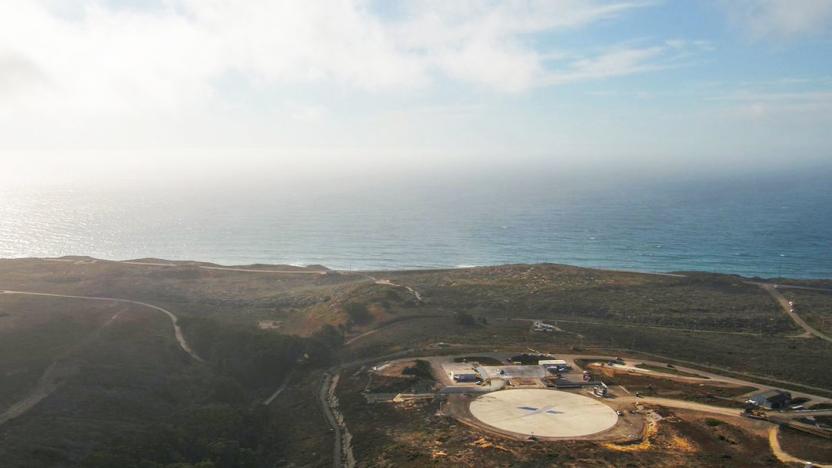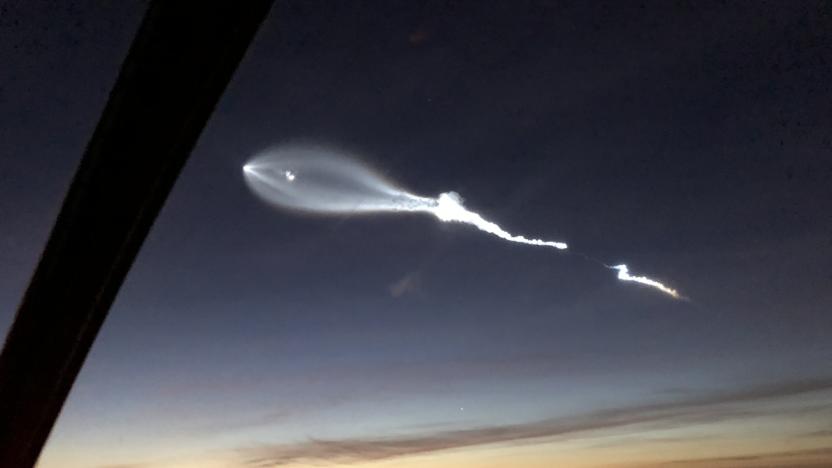VandenbergAirForceBase
Latest

Watch SpaceX's first West Coast ground landing at 10:21PM ET (update: success)
SpaceX may be an old hand at rocket landings by this point, but there are still a few firsts left. The private spaceflight company is launching Argentina's SAOCOM 1A satellite from Vandenberg Air Force Base at 10:21PM Eastern (7:21PM Pacific), and you'll want to watch what happens on the way down. If all goes according to plan, this will be SpaceX's first ground landing on the West Coast -- it used a drone ship for California missions until now. You can start watching live on YouTube (below) 15 minutes before takeoff.

SpaceX Falcon 9 launch leaves a creepy cloud over LA
It seems like everyone in southern California is looking up and asking "what is that?" this evening, and after revelations earlier this week about government investigations into unidentified flying objects, UFO is a popular answer. In truth, the trails were left by a SpaceX launch in the last hour from Vandenberg Air Force Base in Santa Barbara, CA. You can watch a live video feed of the launch below.

SpaceX delays its comeback launch to January 14th
SpaceX's much-vaunted return to flight just hit a snag. Iridium has revealed that the Falcon 9 rocket launch has been pushed pack several days to January 14th, at 12:54PM Eastern. Why the long postponement when most delays tend to be a day or two at most? Simply put, the weather at Vandenberg Air Force Base will just be that terrible -- there are "high winds and rain" in the forecast for the next several days.

DARPA's Falcon HTV-2 hypersonic aircraft launches today, does New York to LA in 12 minutes (update: lost in flight)
All eyes are on Vandenberg Air Force Base in California today, where DARPA's Falcon HTV-2 unmanned aircraft is scheduled to launch into space at hypersonic speeds, as part of a critical test flight. Measuring just 12 feet in length, the HTV-2 maxes out at a speed of about 1300 16,700 miles per hour (Mach 22), theoretically allowing it to jet from New York to Los Angeles in just 12 minutes and to reach anywhere in the world in less than an hour. The main obstacle, however, has been transitioning from theory to practice. During its first test flight back in April, the craft lasted just nine minutes before intentionally crashing, due to technical failures. DARPA still doesn't know what went wrong during that fateful test, though the agency speculates that the Falcon may have simply overheated. This time around, engineers have adjusted plane's center of gravity and angle of descent, in the hopes that their creation will fare better when it launches on the back of a Minotaur IV rocket, later today. If the test proves successful, it may help fuel similarly inter-galactic defense projects that the Pentagon is exploring as a means to combat terrorism and enemy states. We'll have to wait a little longer to find out whether this initiative actually takes off, but in the meantime, head past the break for a demo video from DARPA. Update: Sadly, while the Minotaur IV rocket launch and separation were successful, the Falcon HTV-2 itself was lost nine minutes into its flight this morning just as its predecessor was. DARPA did manage to collect data up until the crash (somewhere in the Pacific Ocean), however, and says that it plans to review it over the coming weeks. Third time's the charm, maybe?

SpaceX breaks ground at Vandenberg Air Force Base, continues preparation for 2013 Falcon Heavy launch
End of the US space shuttle program got you down? It doesn't seem to have phased SpaceX, which is still chipper and chugging right along with plans for its bodacious Falcon Heavy. The company recently broke ground at Complex 4 East at the Vandenberg Air Force Base, which Elon Musk's baby will call home, later next year. With twice the payload-to-orbit capacity of Boeing and Lockheed's Delta IV Heavy, and at a third of the cost, the firm hopes its latest will usher in a new era of affordable $100 million launches. If all goes according to plan, the 22-story behemoth will have its inaugural launch in 2013, making it -- we're told -- the most powerful US rocket since Saturn V hurtled the Apollo spacecraft towards the moon. Budget-friendly, rocket-boostin' PR awaits you after the break.



